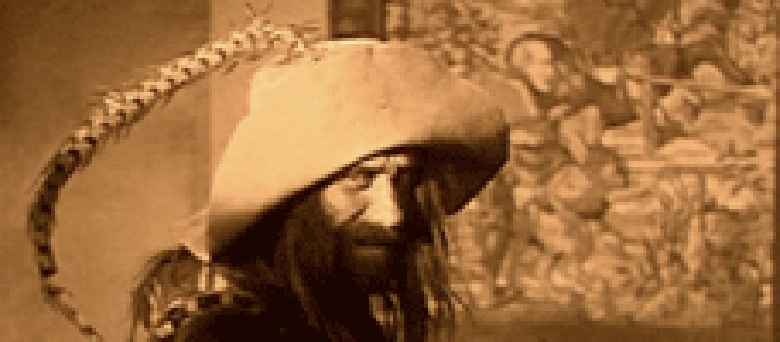Reviews
Le Captain Fracasse
Alberto Cavalcanti & Henry Wulschleger
France, 1929
Credits
Review by Cullen Gallagher
Posted on 16 April 2008
Source Image Entertainment DVD
It’s the closing scene of the movie, and narrative closure and a happy ending seem to be in sight. Mere seconds ago, the hero (Captain Fracasse) saved the damsel in distress (Isabelle) from the clutches of the villain (the Duke), and now the reunited lovers are riding together in a horse-drawn carriage. Their journey comes to a momentary pause in the center of town as an overwhelmingly large crowd has gathered to watch an execution take place—Agostin, a bandit hired by the Duke to murder Captain Fracasse, is sentenced to death for his assassination attempt. The camera shifts focus from Fracasse and Isabelle to the POV of the prisoner as he stares up at his executioner. Agostin takes one last look at the massive crowd before him - a shaky pan again filmed from his POV - before he is strapped to the rack that is to be his final resting place. He is only spared his official sentence by the daring of his young lover, who leaps to the stage and stabs him before running off. The film then shifts back to Fracasse and Isabelle as they ride off into the sunset and a joyous future.
Such is the unexpectedly dismal ending of Alberto Cavalcanti and Henry Wulschleger’s picaresque swashbuckler Captain Fracasse. The plot is fairly pedestrian - Fracasse, a nobleman whose family has lost all their wealth, takes up with an acting troupe, falls in love with the ingénue (Isabelle), and battles for her hand in marriage with a fiendish Duke who constantly attempts to kidnap her and assassinate Fracasse - but Cavalcanti and Wulschleger invigorate the movie with an unorthodox, modernist visual sensibility. Scenes of the troupe rehearsing are punctuated by close-ups of cows faces; performances take on surreal dimensions with bizarre masks that remind of Judex, and disorienting first-person close-ups of the audience; a seedy bar is given a hallucinatory twist by double-exposing it with fire; an upside-down reflection of a castle in a moat is slowly distorted by a swimmer’s waves; and a 180° pan passes over four sword-wielding opponents staring (and pointing their weapons) directly at the camera. In moments such as these, Cavalcanti and Wulschleger co-opt modernistic techniques from the avant-garde and seamlessly integrate them into a highly conventional story. It is worth noting that several years earlier, in 1926, Cavalcanti directed the legendary “city symphony” Rien que les heures which exhibits his brilliant visual style and flair for re-imagining typically banal scenes through creative and unusual compositions, a technique frequently employ in Captain Fracasse to elevate the film beyond the mundane potential of its script.
What’s shocking about the conclusion of Captain Fracasse is its unbridled sobriety: coming after a fanciful series of swordfights in which no one actually dies, the stark reality of a single death is chilling. And it’s not a romantic death resulting from a noble duel, but rather a punishment pronounced by law. Cavalcanti and Wulschleger’s subversion goes beyond the aesthetic and becomes a political statement about the division between the rich and the poor: while the Duke was given a choice of prison or exile for his crimes, the impoverished bandit is allowed no such luxury and more than just being denied a choice of punishments, he is ultimately denied the choice of living. So much of Captain Fracasse can be written off as a fairy tale, which is why this execution scene is so powerful, because it is a moment when the fantastic façade of the fiction falls away to reveal a gritty reality: that actions have consequences, and while the rich are allowed to live a fairy tale existence, those less privileged do not always retain the authorship of their own destinies. So when the movie cuts back to Fracasse and Isabelle in their carriage - riding off to a happy future - Cavalcanti and Wulschleger are both showing a traditional “happy ending” and simultaneously denying the audience any participation or satisfaction.
Yet while turning the genre on its head and exposing all its narrative and political fallacies, the ending doesn’t feel at all self-conscious on the part of the filmmaker, as it might for someone like Michael Haneke. Whereas in 71 Fragments of a Chronology of Chance Haneke dragged audiences (against their will) through a frustratingly disjointed narrative only to deny them any senses of closure, Cavalcanti and Wulschleger are never so obvious about their motivations. Up until that final scene, the narrative proceeds with such convincing conventionality that were the execution to be extracted and the happy ending left uninterrupted, nothing would seem afoot or out-of-place. Ultimately, this works to the film’s advantage: because we are not set-up for subversion, the interruption of the scene succeeds as just that—an interruption. Caught off guard, our empathy with the main characters is broken, and in the course of a few shots, Cavalcanti and Wulschleger manage to debunk an established aesthetic and narrative myth (the kind of which Captain Fracasse is seemingly built upon), essentially re-defining the entire movie, and forcing audiences to reconsider their investment in both the film and the broader context of the swashbuckler genre.
We don’t do comments anymore, but you may contact us here or find us on Twitter or Facebook.



